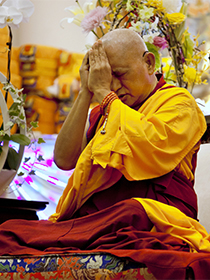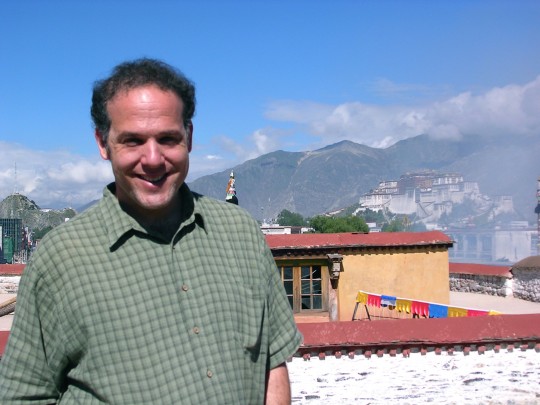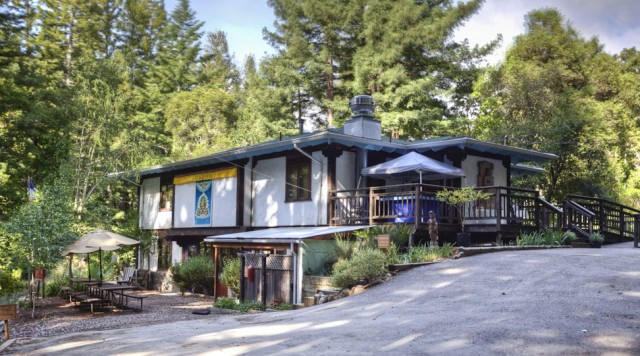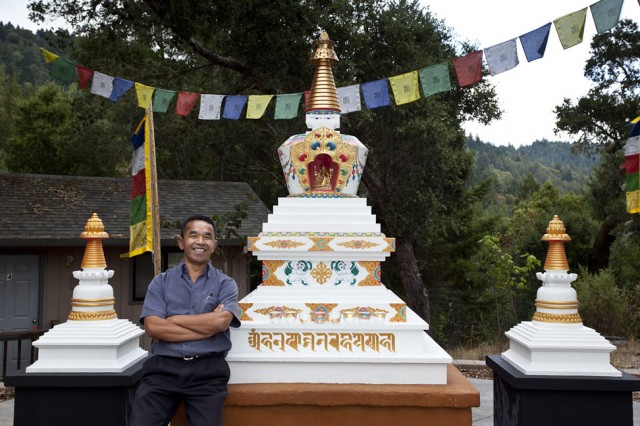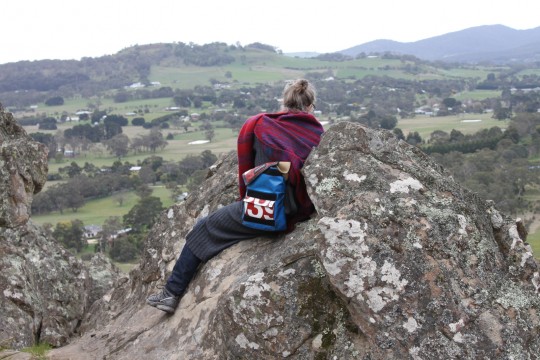- Home
- FPMT Homepage

Foundation for the Preservation of the Mahayana Tradition
The FPMT is an organization devoted to preserving and spreading Mahayana Buddhism worldwide by creating opportunities to listen, reflect, meditate, practice and actualize the unmistaken teachings of the Buddha and based on that experience spreading the Dharma to sentient beings. We provide integrated education through which people’s minds and hearts can be transformed into their highest potential for the benefit of others, inspired by an attitude of universal responsibility and service. We are committed to creating harmonious environments and helping all beings develop their full potential of infinite wisdom and compassion. Our organization is based on the Buddhist tradition of Lama Tsongkhapa of Tibet as taught to us by our founders Lama Thubten Yeshe and Lama Thubten Zopa Rinpoche.
- Willkommen
Die Stiftung zur Erhaltung der Mahayana Tradition (FPMT) ist eine Organisation, die sich weltweit für die Erhaltung und Verbreitung des Mahayana-Buddhismus einsetzt, indem sie Möglichkeiten schafft, den makellosen Lehren des Buddha zuzuhören, über sie zur reflektieren und zu meditieren und auf der Grundlage dieser Erfahrung das Dharma unter den Lebewesen zu verbreiten.
Wir bieten integrierte Schulungswege an, durch denen der Geist und das Herz der Menschen in ihr höchstes Potential verwandelt werden zum Wohl der anderen – inspiriert durch eine Haltung der universellen Verantwortung und dem Wunsch zu dienen. Wir haben uns verpflichtet, harmonische Umgebungen zu schaffen und allen Wesen zu helfen, ihr volles Potenzial unendlicher Weisheit und grenzenlosen Mitgefühls zu verwirklichen.
Unsere Organisation basiert auf der buddhistischen Tradition von Lama Tsongkhapa von Tibet, so wie sie uns von unseren Gründern Lama Thubten Yeshe und Lama Thubten Zopa Rinpoche gelehrt wird.
- Bienvenidos
La Fundación para la preservación de la tradición Mahayana (FPMT) es una organización que se dedica a preservar y difundir el budismo Mahayana en todo el mundo, creando oportunidades para escuchar, reflexionar, meditar, practicar y actualizar las enseñanzas inconfundibles de Buda y en base a esa experiencia difundir el Dharma a los seres.
Proporcionamos una educación integrada a través de la cual las mentes y los corazones de las personas se pueden transformar en su mayor potencial para el beneficio de los demás, inspirados por una actitud de responsabilidad y servicio universales. Estamos comprometidos a crear ambientes armoniosos y ayudar a todos los seres a desarrollar todo su potencial de infinita sabiduría y compasión.
Nuestra organización se basa en la tradición budista de Lama Tsongkhapa del Tíbet como nos lo enseñaron nuestros fundadores Lama Thubten Yeshe y Lama Zopa Rinpoche.
A continuación puede ver una lista de los centros y sus páginas web en su lengua preferida.
- Bienvenue
L’organisation de la FPMT a pour vocation la préservation et la diffusion du bouddhisme du mahayana dans le monde entier. Elle offre l’opportunité d’écouter, de réfléchir, de méditer, de pratiquer et de réaliser les enseignements excellents du Bouddha, pour ensuite transmettre le Dharma à tous les êtres. Nous proposons une formation intégrée grâce à laquelle le cœur et l’esprit de chacun peuvent accomplir leur potentiel le plus élevé pour le bien d’autrui, inspirés par le sens du service et une responsabilité universelle. Nous nous engageons à créer un environnement harmonieux et à aider tous les êtres à épanouir leur potentiel illimité de compassion et de sagesse. Notre organisation s’appuie sur la tradition guéloukpa de Lama Tsongkhapa du Tibet, telle qu’elle a été enseignée par nos fondateurs Lama Thoubtèn Yéshé et Lama Zopa Rinpoché.
Visitez le site de notre Editions Mahayana pour les traductions, conseils et nouvelles du Bureau international en français.
Voici une liste de centres et de leurs sites dans votre langue préférée
- Benvenuto
L’FPMT è un organizzazione il cui scopo è preservare e diffondere il Buddhismo Mahayana nel mondo, creando occasioni di ascolto, riflessione, meditazione e pratica dei perfetti insegnamenti del Buddha, al fine di attualizzare e diffondere il Dharma fra tutti gli esseri senzienti.
Offriamo un’educazione integrata, che può trasformare la mente e i cuori delle persone nel loro massimo potenziale, per il beneficio di tutti gli esseri, ispirati da un’attitudine di responsabilità universale e di servizio.
Il nostro obiettivo è quello di creare contesti armoniosi e aiutare tutti gli esseri a sviluppare in modo completo le proprie potenzialità di infinita saggezza e compassione.
La nostra organizzazione si basa sulla tradizione buddhista di Lama Tsongkhapa del Tibet, così come ci è stata insegnata dai nostri fondatori Lama Thubten Yeshe e Lama Zopa Rinpoche.
Di seguito potete trovare un elenco dei centri e dei loro siti nella lingua da voi prescelta.
- 欢迎 / 歡迎
简体中文
“护持大乘法脉基金会”( 英文简称:FPMT。全名:Foundation for the Preservation of the Mahayana Tradition) 是一个致力于护持和弘扬大乘佛法的国际佛教组织。我们提供听闻,思维,禅修,修行和实证佛陀无误教法的机会,以便让一切众生都能够享受佛法的指引和滋润。
我们全力创造和谐融洽的环境, 为人们提供解行并重的完整佛法教育,以便启发内在的环宇悲心及责任心,并开发内心所蕴藏的巨大潜能 — 无限的智慧与悲心 — 以便利益和服务一切有情。
FPMT的创办人是图腾耶喜喇嘛和喇嘛梭巴仁波切。我们所修习的是由两位上师所教导的,西藏喀巴大师的佛法传承。
繁體中文
護持大乘法脈基金會”( 英文簡稱:FPMT。全名:Found
ation for the Preservation of the Mahayana Tradition ) 是一個致力於護持和弘揚大乘佛法的國際佛教組織。我們提供聽聞, 思維,禪修,修行和實證佛陀無誤教法的機會,以便讓一切眾生都能 夠享受佛法的指引和滋潤。 我們全力創造和諧融洽的環境,
為人們提供解行並重的完整佛法教育,以便啟發內在的環宇悲心及責 任心,並開發內心所蘊藏的巨大潛能 — 無限的智慧與悲心 – – 以便利益和服務一切有情。 FPMT的創辦人是圖騰耶喜喇嘛和喇嘛梭巴仁波切。
我們所修習的是由兩位上師所教導的,西藏喀巴大師的佛法傳承。 察看道场信息:
- FPMT Homepage
- News/Media
-
- Study & Practice
-
-
- About FPMT Education Services
- Latest News
- Programs
- New to Buddhism?
- Buddhist Mind Science: Activating Your Potential
- Heart Advice for Death and Dying
- Discovering Buddhism
- Living in the Path
- Exploring Buddhism
- FPMT Basic Program
- FPMT Masters Program
- FPMT In-Depth Meditation Training
- Maitripa College
- Lotsawa Rinchen Zangpo Translator Program
- Universal Education for Compassion & Wisdom
- Online Learning Center
-
- Prayers & Practice Materials
- Overview of Prayers & Practices
- Full Catalogue of Prayers & Practice Materials
- Explore Popular Topics
- Benefiting Animals
- Chenrezig Resources
- Death & Dying Resources
- Lama Chopa (Guru Puja)
- Lama Zopa Rinpoche: Compendium of Precious Instructions
- Lama Zopa Rinpoche: Life Practice Advice
- Lama Zopa Rinpoche Practice Series
- Lamrim Resources
- Mantras
- Prayer Book Updates
- Purification Practices
- Sutras
- Thought Transformation (Lojong)
- Audio Materials
- Dharma Dates - Tibetan Calendar
- Translation Services
- Publishing Services
- Ways to Offer Support
- Prayers & Practice Materials
-
- Teachings and Advice
- Find Teachings and Advice
- Lama Zopa Rinpoche Advice Page
- Lama Zopa Rinpoche: Compendium of Precious Instructions
- Lama Zopa Rinpoche Video Teachings
- ༧སྐྱབས་རྗེ་བཟོད་པ་རིན་པོ་ཆེ་མཆོག་ནས་སྩལ་བའི་བཀའ་སློབ་བརྙན་འཕྲིན།
- Podcasts
- Lama Yeshe Wisdom Archive
- Buddhism FAQ
- Dharma for Young People
- Resources on Holy Objects
- Teachings and Advice
-
-
*If a menu item has a submenu clicking once will expand the menu clicking twice will open the page.
-
-
- Centers
-
- Teachers
-
- Projects
-
-
-
-
*If a menu item has a submenu clicking once will expand the menu clicking twice will open the page.
-
-
- FPMT
-
-
-
-
-
If you don’t know your own psychology, you might ignore what’s going on in your mind until it breaks down and you go completely crazy.
Lama Thubten Yeshe
-
-
-
- Shop
-
-
-
The Foundation Store is FPMT’s online shop and features a vast selection of Buddhist study and practice materials written or recommended by our lineage gurus. These items include homestudy programs, prayers and practices in PDF or eBook format, materials for children, and other resources to support practitioners.
Items displayed in the shop are made available for Dharma practice and educational purposes, and never for the purpose of profiting from their sale. Please read FPMT Foundation Store Policy Regarding Dharma Items for more information.
-
-
FPMT News Around the World
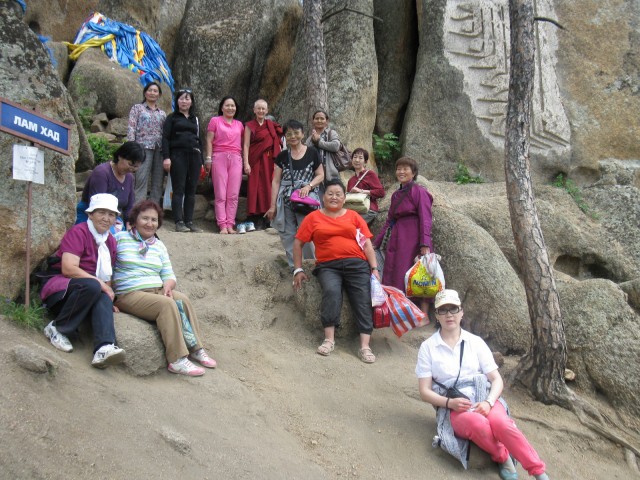
The students of Golden Light Sutra Center negotiated the terrain around Aglag Monastery with ease, Darkhan, Mongolia, July 2014. Photo courtesy of Ven. Tezin Tsapel.
Ven. Tenzin Tsapel, director of Golden Light Sutra Center in Darkhan, Mongolia, reports on the group’s celebration of His Holiness the Dalai Lama’s July 6, 2014 birthday:
A group Golden Light Sutra Center students went on a sutra reading picnic for His Holiness’ birthday celebration. We hired a mini-bus for the two-hour drive to Aglag Monastery, 13 kilometers (8 miles) off the Darkhan/Ulaanbaatar road. As we drove in, the valley became quite narrow, and heavily treed, very green and culminated in small, steep mountain with unusual natural rocky outcrops, enclosed by a ring of mountains. From the car park we walked up the step gravel drive to the main monastery and cluster of buildings. The center piece was an ornately painted monastery building with a commanding view.
We settled in to recite the Vajra Cutter Sutra in front of the central Amitabha altar and then joined the stream of visitors upstairs paying respect to the holy images and Buddha relics and viewing an odd assortment of mythical beast models.
The path led behind the main building and around a very beautiful but very steep and slippery mountain track past numerous carved holy images, mantras and syllables, as well as a few obstacle-course rock formations. My initial concern for some of the older members of our group gave way to respect as our hardy Mongolian ladies made their way around mountain. We stopped on the way for some birthday cake and fruit and made our way to the grass base for our late picnic lunch.
Mandala brings you news of Lama Zopa Rinpoche and of activities, teachings and events from over 160 FPMT centers, projects and services around the globe. If you like what you read on Mandala, consider becoming a Friend of FPMT, which supports our work.
- Tagged: golden light sutra center, mandala, mongolia
- 0
9
Mandala is mourning the loss of our dear friend Dr. James Blumenthal, who passed away very early in the morning of October 8, 2014, at age 47, due to complications from cancer. Jim was a regular contributor to Mandala for many years. He was also a talented and generous scholar, teacher and colleague, serving as a professor of Buddhist philosophy and history at Maitripa College as well as at Oregon State University in the United States. He was a student of Geshe Lhundub Sopa Rinpoche at the University of Wisconsin, where he received his PhD.
Jim was quick to say “yes” whenever we asked him for an article for Mandala and his submissions arrived on time and were beautifully written. He had great depth of knowledge and a sharp mind, yet was always humble and gracious. He had the wonderful ability to make the sometimes complicated and difficult-to-understand world of Buddhist philosophy accessible and fascinating to the not-so-academically inclined. His gentle kindness, clear explanations and always interesting stories will be profoundly missed.
Jim’s death is a great loss for Maitripa College, where he taught since its founding. Jim is survived by his seven-year-old son Ben, wife Tiffany, parents Susan and Jack, brother Tom and Ben’s mother Sara, who was the former editor and publisher of Mandala.
As a small remembrance of Jim, we’ve upload several PDFs of his Mandala articles from archive issue, which you can find here.
Maitripa College has created a webpage for Jim with a collection of prayers that may be recited and dedicated for him. Also on the page, you will find Jim’s translation of Shatarakshita’s Ornament of the Middle Way, a link to a memorial page and a touching video remembrance of Jim by Ven. Thubten Chodron.
Oregon State University has published a moving tribute of Jim.
Mandala will run a full obituary in our next issue.
Mandala brings you news of Lama Zopa Rinpoche and of activities, teachings and events from over 160 FPMT centers, projects and services around the globe. If you like what you read on Mandala, consider becoming a Friend of FPMT, which supports our work.
- Tagged: james blumenthal, maitripa college, obituaries
- 0
9
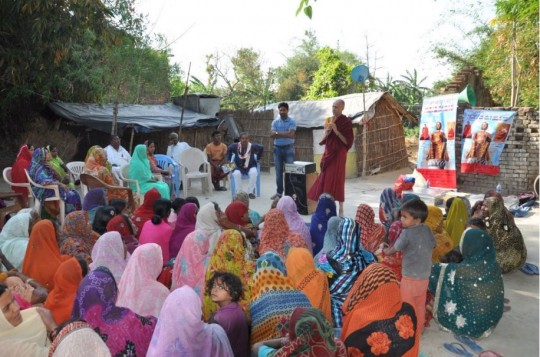
Ven. Kabir Saxena and Hari Om, MPT Healthcare Program staff, offer basic health education to villagers, Kushinagar, India, March 2014. Photo courtesy of Maitreya Project Trust.
In March 2014, Maitreya Project Trust (MPT), the organization responsible for constructing a very large Maitreya statue in Kushinagar, India, began offering basic medical services to villagers affected by the project. The MPT Healthcare Project, one of MPT’s social programs, purchased a large van and toured the countryside, offering basic education on hygiene and alcohol abuse, and forming partnerships with village officials. The van will travel to Delhi to be converted into a fully functioning mobile clinic and soon doctors, nurses and support staff will be hired to expand MPT Healthcare Project’s services and outreach.
This September, MPT collaborated with Kushinagar District Magistrate’s Office to begin distributing 3,500 mosquito nets together with reading material about malaria and other infectious diseases. Hundreds of people lined up to receive the first 1,000 nets during the inaugural health camp, and many more are expected to come in October during the second.
At the advice of Lama Zopa Rinpoche, MPT is making plans to distribute 3,500 wool blankets in December, when temperatures can dip to 40°F (4°C), to the area’s poorest.
Progress continues being made on the statue itself, with MPT staff estimating that they will be able to receive 200 acres of land by the end of 2014 and begin the long process of fencing the boundary, setting up their office and welcoming a 24-foot (7-meter) Maitreya statue from Bodhgaya to Kushinagar for auspiciousness.
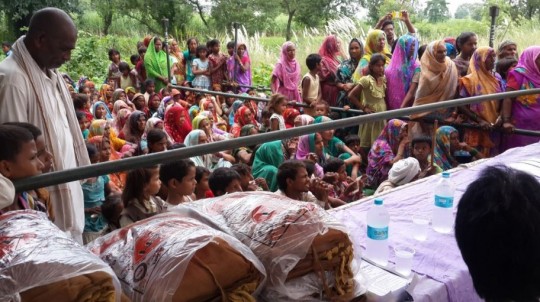
MPT Healthcare Program distributes 1,000 mosquito nets to Kushinagar residents, India, September 2014. Photo courtesy of Maitreya Project Trust.
More about Maitreya Project Trust and its accomplishments can be found in its October 2014 update.
You can support Maitreya Project Trust, including the MPT Healthcare Project, by visiting FPMT.org.
Mandala brings you news of Lama Zopa Rinpoche and of activities, teachings and events from over 160 FPMT centers, projects and services around the globe. If you like what you read on Mandala, consider becoming a Friend of FPMT, which supports our work.
- Tagged: kushinagar, maitreya project trust
- 0
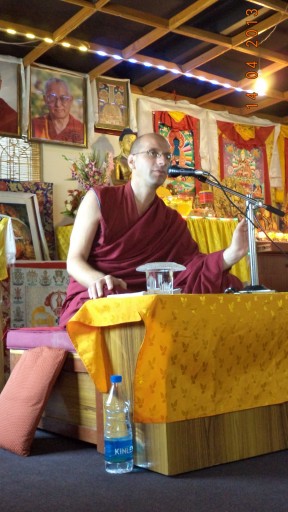
Ven. Tenzin Namdak teaching at Choe Khor Sum Ling, Bangalore, India, April 2013. Photo courtesy of Choe Khor Sum Ling.
“As part of the ongoing Discovering Buddhism course at Choe Khor Sum Ling, we recently organized a four-day non-residential retreat,” said center member Shanti Gopinath in an email to Mandala in July. “Under the adept guidance of Ven. Tenzin Legtsok from Sera Je, students reflected and meditated upon the outlines of two topics from the program: ’The Spiritual Teacher’ and ’Death and Rebirth.’ The meditation sessions invigorated all that we learned theoretically in these two modules. The retreats included reflection and guided meditation. Ven. Legtsok’s pragmatic approach to the reflection, contemplation and meditation process made the concepts easier to understand, clearer and deep seated in our minds.”
“Bangaloreans are mostly a staunch working community and so a non-residential retreat in the heart of the city was well received. Participants were happy to break away from everyday monotony and the distractions of ordinary life.
“Our next four-day residential retreat in August 2014 will be at Gyume Tantric Monastery in Hunsur. The retreat will be led by Ven. Tenzin Namdak from Sera Je. The retreat will incorporate guided meditations focused around the topics outlined in the Discovering Buddhism modules ‘All About Karma’ and ‘Refuge.’ Gyume Monastery is in a Tibetan farming settlement four hours’ drive from Bangalore and is a perfect setting for our next retreat.”
Mandala brings you news of Lama Zopa Rinpoche and of activities, teachings and events from over 160 FPMT centers, projects and services around the globe. If you like what you read on Mandala, consider becoming a Friend of FPMT, which supports our work.
- Tagged: choe khor sum ling, mandala
- 0
2
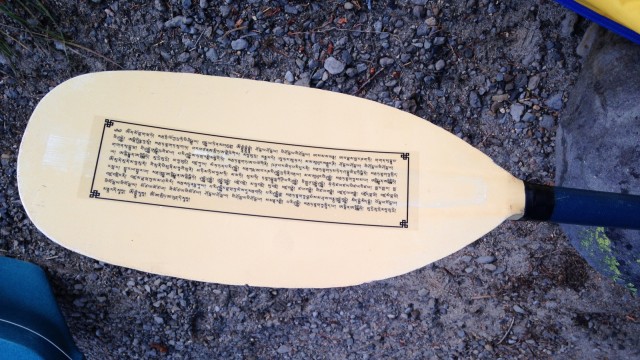
Kayak paddle with Namgyälma mantra, Waldo Lake, Oregon, US, August 2014. Photo courtesy of Mandala Publications.
A third-year Maitripa College student sent Mandala this idea on how to use the Namgyälma mantra to make kayaking a more beneficial experience. “The Namgyälma mantra is extremely powerful,” Lama Zopa Rinpoche teaches. “It is the main mantra to purify and liberate beings from the lower realms, purify negative karma, and help those who are dying or have died ….” Here is her account:
During a rituals and ethics class, we learned about water tsa-tsas. While kayaking one day, I started thinking about how many times my paddle was in the water. I wondered if there was a way to do something like the water tsa-tsas with my paddle.
I came across an article about Lama Zopa Rinpoche’s Namgyälma mantra board and blessing all the creatures in the water and whomever comes in contact with the water. I put two and two together and started asking around about a way to put a mantra on a kayak paddle.
The mantra that I used is actually a bumper sticker that I got through the FPMT Foundation Store. Before putting on the sticker, I first did the Jorchö practice and recited some of the mantras I found in the tsa-tsa book. Afterward, I dedicated the merit. Since it’s important to protect the mantra, I cover both of the paddle blades with stuff sacks for storage, taking them off before paddling and putting them back on when I’m done.
The new stickers have really changed the way I treat my paddles and my mindset while paddling. I recite a mantra most of the time as I paddle and dedicate at the end of the kayak outing.
The Foundation Store, managed by FPMT International Office, provides Dharma materials and supplies to interested students around the world. All proceeds from the shop are used to further the charitable mission of FPMT Inc.
Mandala brings you news of Lama Zopa Rinpoche and of activities, teachings and events from over 160 FPMT centers, projects and services around the globe. If you like what you read on Mandala, consider becoming a Friend of FPMT, which supports our work.
- Tagged: maitripa college, mandala, namgyalma mantra
- 0
30
Inspiration ‘Reboot’ at CPMT 2014 – Wrapping Up a Packed Week
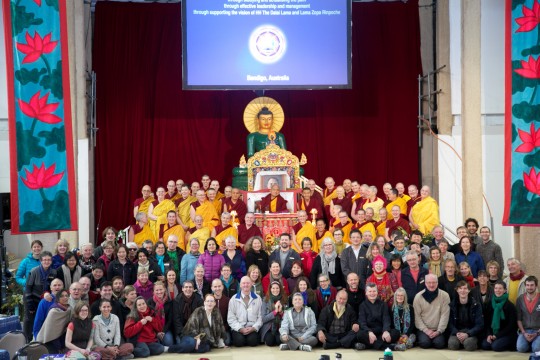
FPMT spiritual director Lama Zopa Rinpoche with CPMT 2014 meeting participants in the Great Stupa of Universal Compassion, Australia, September 2014. Photo by Steve Alberts.
What will participants remember most about CPMT 2014? Judging by the feedback they provided, it’s getting a big dose of inspiration from an intense week of connecting with FPMT spiritual director Lama Zopa Rinpoche, the international FPMT community and FPMT’s distinctive Wisdom Culture. It seemed for everyone in attendance that the warmth of CPMT’s “family feeling” filling up the Great Stupa of Universal Compassion, where the meeting was held, eclipsed the chilly meeting venue.
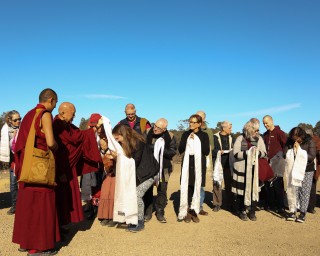
Offering khatas to Lama Zopa Rinpoche at the beginning of CPMT 2014, Great Stupa of Universal Compassion, Australia, Photo by Ven. Thubten Kunsang.
Here are a few positive things that stood out for CPMT meeting participants:
- “Rinpoche’s presence! Getting to interact with everyone over to course of the conference due to inclusive group work.”
- “Getting to ‘reboot’ my inspiration in working for FPMT and serving sentient beings.”
- “Hearing the stories of Ven. Gyatso (Adrian Feldmann) and other long-term students who were there from the beginning.”
- “I liked very much the group discussions and that Rinpoche came to some of the sessions.”
- “Putting faces to emails. “
- “Learning what other projects are happening was very inspiring. The [Vast Visions that] are up and running expands my perspective considerably.”
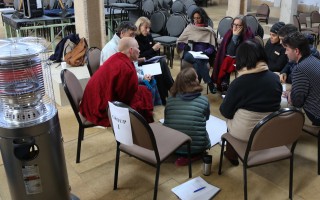
A space heater and a small group discussion at CPMT 2014, Great Stupa of Universal Compassion, Australia, September 2014. Photo by Ven. Thubten Kunsang.
Claire Isitt, FPMT Center Services director and coordinator of CPMT 2014 commented, “What a wonderful CPMT meeting that was. Some said the best so far. We were supremely blessed with lots of time and advice from Lama Zopa Rinpoche, who also joined in some of the small group discussions. The meeting venue was completely inspiring – and the cold kept us alert! I’m enormously grateful to all who worked so hard to make the meeting so beneficial – the CPMT committee, the host team and volunteers, our wonderful facilitator, the presenters (including the wonderful older students who gave the very inspiring Wisdom Culture evening talks), small group facilitators, Ven. Joan Nicell for transcribing, the AV team who enabled so many to be present for Rinpoche’s talks via livestream – and all who made it to Bendigo, Australia, to participate in our amazing international meeting. Wow, wow, wow!”
According to the 88 meeting participants who completed the “CPMT 2014: Evaluation and Feedback” survey, the most common criticism of the event can be summed up as follows: “Too much happening, too little time to let things settle in.” The seven-day meeting’s schedule was full of talks by Lama Zopa Rinpoche, presentations and small group discussions, which for many didn’t leave much time for reflection or lengthy in-depth discussion. Other critical comments reflected some of the difficulties of hosting a large meeting in what is in essence a construction site – the unheated accommodations and meetings space combined with the cold temperatures of Australia’s early spring and the reliance on portable sanitation facilities drew many comments.
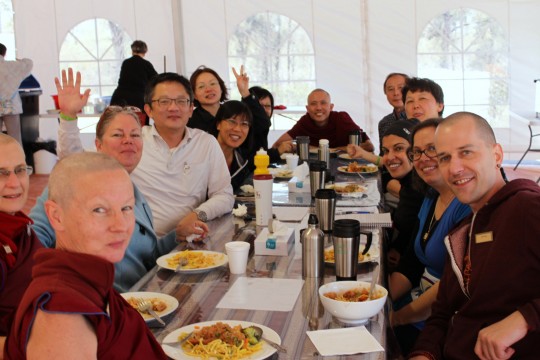
Participants from the Southeast Asia region at lunch, CPMT 2014, Australia, September 2014. Photo by Laura Miller.
But despite it all, participants overwhelmingly said that they would encourage others to attend the next CPMT. Here are a few things they would say to a center director or SPC considering whether to go:
- “Do join because is highly inspirational and informative and gives lots of ideas to implement in one’s own center.”
- “I would encourage them strongly as it is critical to align them with FPMT globally so there is a strong sense of the entire FPMT mandala, otherwise center personnel can feel they are operating in a vacuum.”
- “You’d be crazy to miss it! Having direct advice and input from LZR [Lama Zopa Rinpoche] is so, so, so special.”
The meeting minutes and other reports from CPMT will be made available as they are completed. Watch the CPMT e-group for updates.
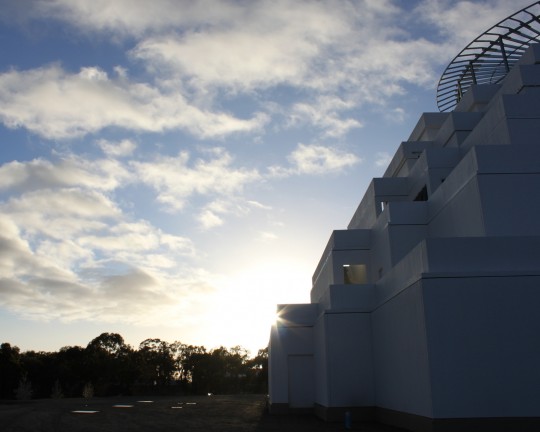
The morning sun at the Great Stupa of Universal Compassion, Bendigo, Victoria, Australia, September 17, 2014. Photo by Laura Miller.
Mandala brings you news of Lama Zopa Rinpoche and of activities, teachings and events from over 160 FPMT centers, projects and services around the globe. If you like what you read on Mandala, consider becoming a Friend of FPMT, which supports our work.
You can find more coverage of CPMT 2014 on our blog.
- Tagged: australia, cpmt, cpmt 2014, great stupa of universal compassion
- 0
20
Day 7 of CPMT 2014: Long Life Puja for Lama Zopa Rinpoche
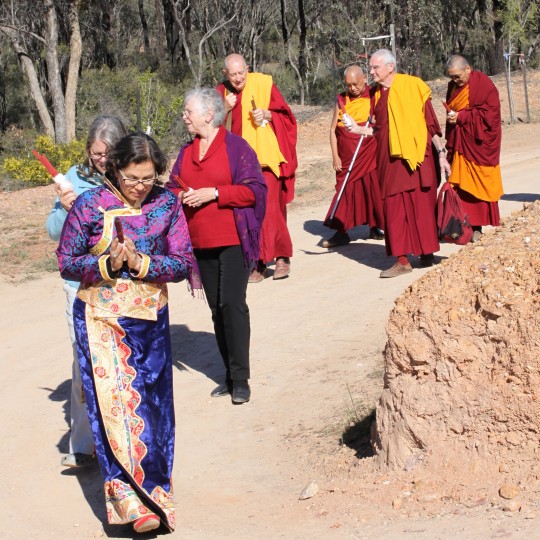
Lama Zopa Rinpoche being led to the long life puja in the Great Stupa of Universal Compassion by (from right) Khen Rinpoche Geshe Chonyi, FPMT CEO Ven. Roger Kunsang, Thubten Shedrup Ling director Gyatso, FPMT Board of Directors secretary Paula de Wys, FPMT Australia coordinator Helen Patrin and FPMT Center Services director Claire Isitt, Australia, September 19, 2014. Photo by Laura Miller.
The CPMT 2014 meeting came to a close on Friday, September 19, with a moving long life puja for Lama Zopa Rinpoche. Meeting participants, volunteers from Atisha Centre and Great Stupa of Universal Compassion, monks from Thubten Shedrup Ling and other community members harmoniously created a beautiful gompa inside the Great Stupa of Universal Compassion for the puja.
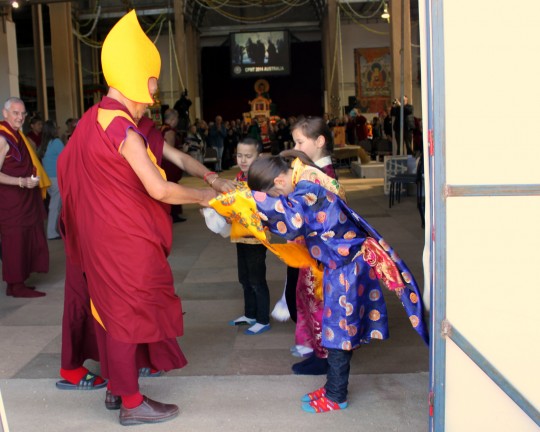
Lama Zopa Rinpoche entering the Great Stupa of Universal Compassion for the long life puja, Australia, September 19, 2014. Photo by Laura Miller.
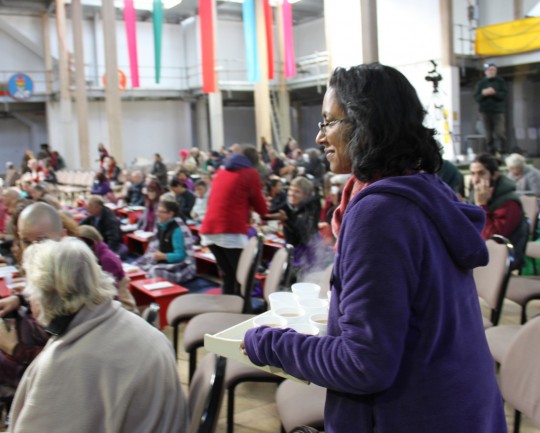
Mallika Krishnamurthy distributing tea during the long life puja, Great Stupa of Universal Compassion, Australia, September 19, 2014. Photo by Laura Miller.
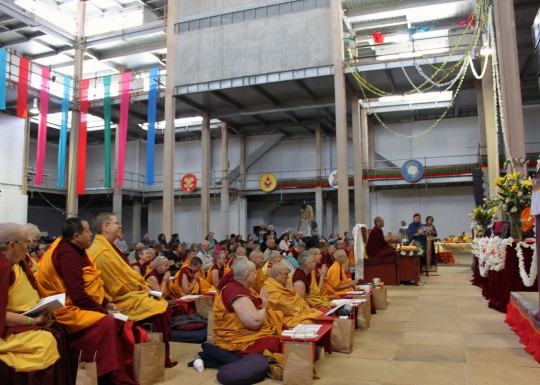
During the reading of the praises for Lama Zopa Rinpoche, Great Stupa of Universal Compassion, Australia, September 19, 2014. Photo by Laura Miller.
Despite the chilly temperature inside the Great Stupa during the meeting, participants in CPMT 2014 appeared satisfied with the meeting’s accomplishments and happy to have been able to spend time with each other, renewing old friendships and creating new. The CPMT committee, who organized the seven-day meeting, felt the meeting was an overall success. Minutes from the entire meeting will be made available.
The A/V team worked tirelessly to not only record the entire meeting but also to make sure that Lama Zopa Rinpoche’s teachings during CPMT were webcast around the world and are available as video recordings on the CPMT Livestream page. Ven. Joan Nicell performed her magic, instantly transcribing Rinpoche’s words on to a projected screen. Transcriptions of Rinpoche’s teaching will also be made available as they are ready.
After a brief interlude, Lama Zopa Rinpoche will be leading the month-long Bodhicaryavatara and Rinjung Gyatsa retreat, September 25-October 23, at the Great Stupa. Rinpoche’s teachings will be webcast live on the retreat Livestream page.
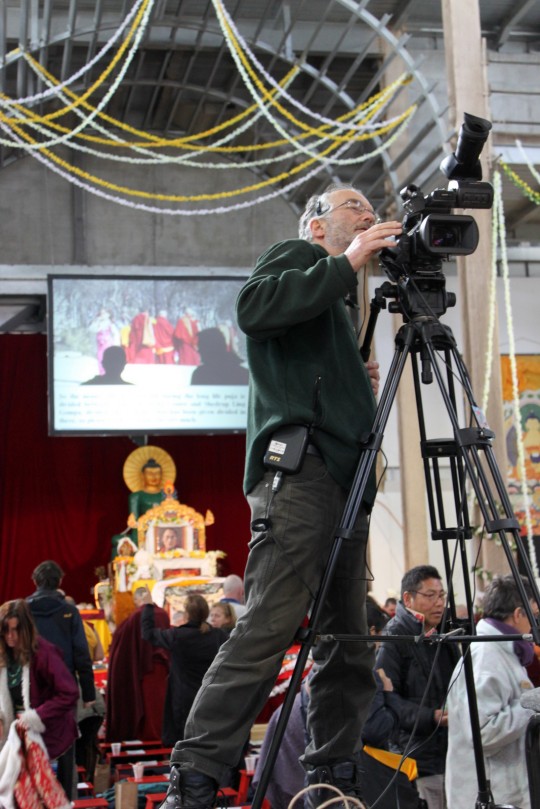
Camera man Peter Lane filming the very end of the long life puja, Great Stupa of Universal Compassion, Australia, September 19, 2014. Photo by Laura Miller.
You can find Mandala‘s coverage of CPMT 2014 on our blog.
Mandala brings you news of Lama Zopa Rinpoche and of activities, teachings and events from over 160 FPMT centers, projects and services around the globe. If you like what you read on Mandala, consider becoming a Friend of FPMT, which supports our work.
- Tagged: cpmt, cpmt 2014, lama zopa rinpoche, long life puja
- 0
19
Day 6 of CPMT 2014: Wisdom Culture
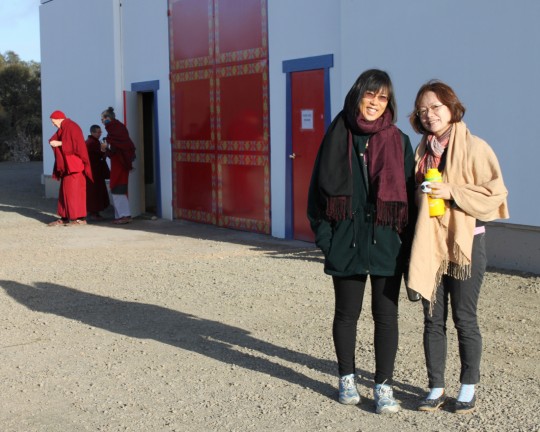
Selina Foong and Candy Tan, Great Stupa of Universal Compassion, Australia, September 2014. Photo by Laura Miller.
Day 6 of the CPMT 2014 meeting began with morning prayers beautifully led by Ven. Gyatso. After breakfast, Sarah Brooks led a morning motivation drawing from the Inner Job Description. At the end of the short reflection, she asked participants to set a goal for how they will benefit beings for the day and write it down so that at the end of the day they can check to see how they’ve done.
Helen Patrin led the morning session on “Keeping the FPMT Wisdom Culture Alive,” the last presentation for the meeting. Helen reminded us that Wisdom Culture is the “foundation of the Foundation of the Preservation of the Mahayana Tradition. … The wisdom and compassion that they have taught us over the years is infused into everything that we do.” Vens. Kunphen and Paloma Alba read out the nine key points of FPMT Wisdom Culture.
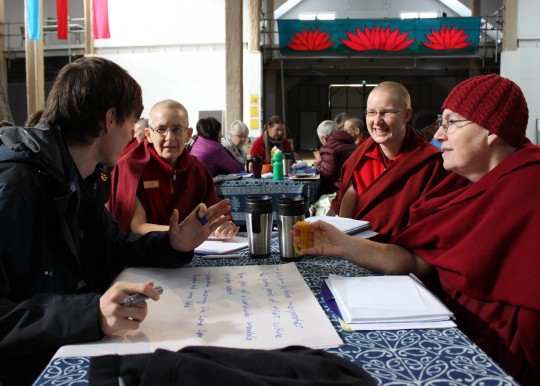
Robert Schwabe, Vens. Tenzin Tsapel, Tenzin Kunphen and Chantal Carrerot, CPMT 2014, Great Stupa of Universal Compassion, Australia, September 2014. Photo by Laura Miller.
There were three small group discussion periods about Wisdom Culture and supporting one’s respective center, project or service. Here are a few of the ideas shared with the large group about what Wisdom Culture is:
- The “family feeling” – the warm feeling of connection – that you experience at any center or project you visit
- A combination of the traditional teachings and an unconventional style, which gives a strong foundation and the freedom to explore in our local environments
- A rich oral tradition of sharing stories and senior students leading by their good example
- A safe path that is inclusive and open, depth and richness that is a living tradition
- Wisdom Culture is about harmony within ourselves and at centers
Dozens more ideas came from the small groups for supporting Wisdom Culture, including sharing videos of Rinpoche and Lama Yeshe. An example of this could be this video posted by the Lama Yeshe Wisdom Archive called “Bringing Dharma to the West – Lama Yeshe: How We Started Teaching Westerners”:
Just before lunch, François Lecointre gave an update on the Maitreya Loving Kindness Tour (formerly the Heart Shrine Relic Tour) complete with a photo presentation of the tour visiting different parts of the world. François shared Rinpoche’s advice on the purpose of the relic tour and explained how the tour, which is a collection of many holy relics from Buddhist masters including the Buddha himself, travels to many different kinds of places. In addition to Dharma centers, the relics visit hospices, prisons, museums and so forth. So far the holy relics have visited 68 countries.
Following a brief financial report on the meeting, all presenters from the previous days were invited to the front to recap their session and describe what comes next.
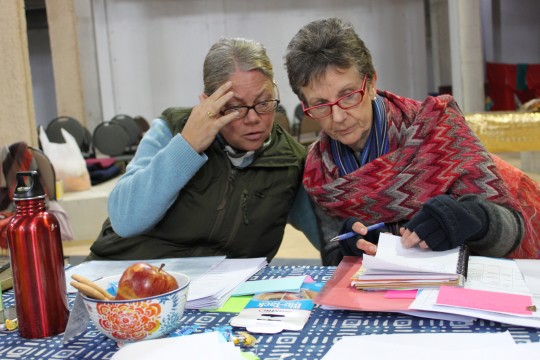
Claire Isitt and Sandra Stubbings going over the agenda on Day 6 of CPMT 2014, Great Stupa of Universal Compassion, Australia, September 18, 2014. Photo by Laura Miller.
“We’ve come from a humble beginning,” Ven. Roger said, referring to Lama Yeshe and Lama Zopa Rinpoche’s initial teachings while penniless monks, to the group of more than 100 sitting inside the Great Stupa. “We’ve achieved a lot and working together we can achieve a lot more.”
After a break for a group photo with Lama Zopa Rinpoche, there was a Lama Chöpa tsog with Rinpoche. Following that, Rinpoche gave the closing talk for the meeting, which focused on practicing bodhichitta. A video recording of Rinpoche’s talk is available on the CPMT Livestream page.
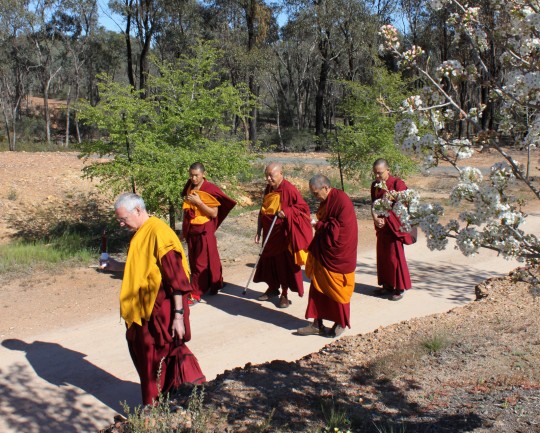
Lama Zopa Rinpoche walking to the Great Stupa of Universal Compassion with Khen Rinpoche Geshe Chonyi and Vens. Roger Kunsang, Sangpo and Sherab, Australia, September 19, 2014. Photo by Laura Miller.
“So if you really are practicing Dharmas, especially the Mahayana teachings … put all the blames to one, that is the ‘I,’” Rinpoche said. “There’s not someone else [to blame]. You are practicing Dharma, so blame the ‘I’, the self-cherishing thought. … Let go of the ‘I’, where all the suffering and obstacles come, let go of that and cherish others. [That is] where all the happiness comes from including enlightenment – all the success”.
After dinner, participants prepared for the next day’s long life puja for Lama Zopa Rinpoche, transforming the meeting space inside the Great Stupa into a proper gompa.
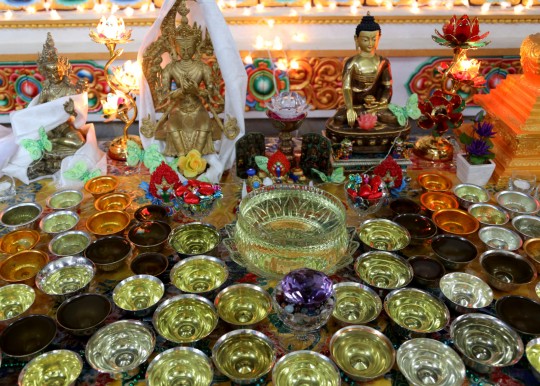
Offerings to the Guru Rinpoche statue in the Great Stupa of Universal Compassion, Australia, September 2014. Photo by Ven. Thubten Kunsang
You can find Mandala‘s coverage of CPMT 2014 on our blog.
Mandala brings you news of Lama Zopa Rinpoche and of activities, teachings and events from over 160 FPMT centers, projects and services around the globe. If you like what you read on Mandala, consider becoming a Friend of FPMT, which supports our work.
- Tagged: cpmt, cpmt 2014, lama zopa rinpoche
- 0
Vajrapani Institute in Boulder Creek, California continues its experiment with “no-fees” Kopan West lam-rim retreats, the next scheduled for November 21-30, 2014 and taught by FPMT-registered teacher Glen Svensson. Kopan West is a 10-day introductory lam-rim course modeled after the successful Kopan November retreats held in Nepal since the early 1970s.
In 2013, the center piloted a new generosity-based system for covering the retreat’s costs, abandoning the traditional fee-centered model. They told participants they would not be charged and asked them at the end of the retreat to instead reflect on what they had gained and make a contribution to next year’s attendees.
“The teachings from Kopan West continue to impact me as I apply Buddhist practices in my daily life and has inspired me to further study,” said Sahar Bintamal, a November 2013 retreatant. “My attendance at Kopan West would not have been possible without the donation/generosity model. I feel honored that my donation will support another student to experience the lam-rim teachings in the coming year.”
Mandala brings you news of Lama Zopa Rinpoche and of activities, teachings and events from over 160 FPMT centers, projects and services around the globe. If you like what you read on Mandala, consider becoming a Friend of FPMT, which supports our work.
- Tagged: kopan west, vajrapani institute
- 0
18
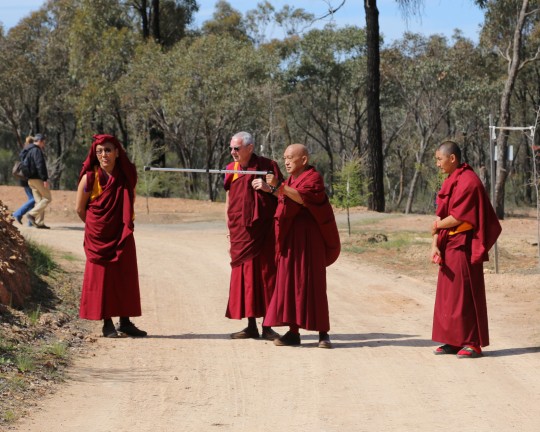
Lama Zopa Rinpoche and Khen Rinpoche Geshe Chonyi with Vens. Roger and Sangpo outside of the Great Stupa of Universal Compassion, Australia, September 2014. Photo by Ven. Thubten Kunsang.
The morning of Day 5 of CPMT 2014, FPMT spiritual director Lama Zopa Rinpoche offered an Amitayus long life initiation. Rinpoche gave a penetrating teaching on emptiness and the merely labeled ‘I’ before offering the initiation. The teaching can be watched as a video recording on the CPMT Livestream page.

Harald Weichart operating a camera during a teaching by Lama Zopa Rinpoche, Great Stupa of Universal Compassion, Australia, September 2014. Photo by Ven. Thubten Kunsang.
In afternoon session, “Aging Care,” Ven. Damcho from the Chenrezig Nuns Community and Isabel Arocena, from Tushita Centro de Retiros, talked about meeting needs of those in our community facing the challenges of chronic illness and aging. Situations vary from country to country and individual to individual, but one of the main points to come out of the session is that individuals can be making initial preparations for their own future spiritual care. This can include examples like writing down your wishes for the practices and prayers to be done at your death and like recording yourself reciting your daily practice for a time when you might not be able. They shared a few examples of how people currently requiring support are managing and receiving the support from the community and friends. An open question and answer session followed.
After dinner, Ian Green, director of the Great Stupa of Universal Compassion, spoke to the group about how the Great Stupa came to be – from Lama Yeshe’s initial instructions given in 1981, to Lama Zopa Rinpoche choosing the type of stupa, to traveling to Tibet to measure the Gyantse Stupa, which the Great Stupa is modeled on, to the present day when the stupa rises 26 meters above the ground, with 22 meters to go. Ian shared the Master Plan based on Lama Yeshe’s vision for the site, which includes a hotel, restaurant, museum, nunnery, lay housing, a primary school and elder care facilities. In 2000, the land for the stupa was cleared. In 2003, the first concrete was laid and Lama Zopa Rinpoche visited. In 2007, His Holiness the Dalai Lama visited and consecrated the large Guru Rinpoche statue and blessed the site. In 2013, the steel framework for bumpa was installed on the top level and 20,000 tourists visited.
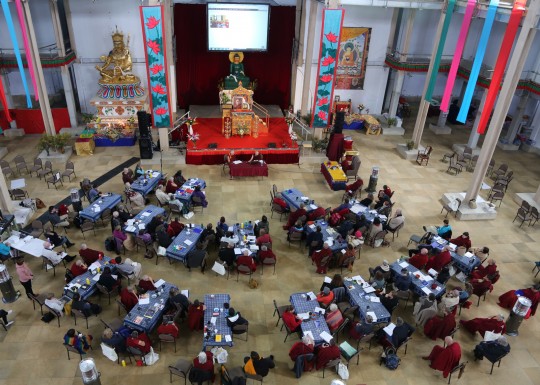
CPMT 2014 meeting, Great Stupa of Universal Compassion, Australia, September 16, 2014. Photo by Ven. Thubten Kunsang.
Ian also talked about the Jade Buddha for Universal Peace, a project that he has developed from its beginnings as a huge boulder of gemstone quality jade to a 2.7-meter (9-foot) tall carved Buddha statue, which has visited 80 cities in 18 countries and drawn 7.4 million people to its exhibitions. The Jade Buddha will have its final home inside the Great Stupa.
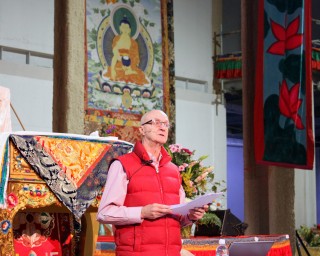
Ian Green sharing about the Great Stupa of Universal Compassion, Australia, September 17, 2014. Photo by Laura Miller.
Since Ian has raised literally millions of dollars for these projects, he shared his rules of fundraising:
- People give to people (integrity is of highest importance)
- Nothing beats face to face
- Honor your benefactors (permanent and visual recognition)
- Database is wish fulfilling tree (prune, nurture, patience)
- Fundraising is a numbers game
Ian recalled that Lama Zopa Rinpoche had once told him, “The greater the merit; the great the obstacles.” More recently Rinpoche said that the Great Stupa was like an big jet plane that had been going down a long runway and was not taking off.
Mandala will continue sharing updates and photos from the CPMT 2014 meeting as the meeting continues.
Mandala brings you news of Lama Zopa Rinpoche and of activities, teachings and events from over 160 FPMT centers, projects and services around the globe. If you like what you read on Mandala, consider becoming a Friend of FPMT, which supports our work.
- Tagged: cpmt, cpmt 2014, great stupa of universal compassion, ian green
- 0
17
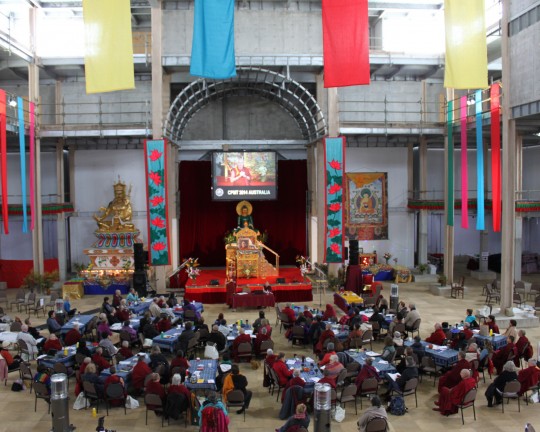
Ven. Roger Kunsang and Ven. Holly Ansett during a presentation on Day 4 of CPMT 2014, Great Stupa of Universal Compassion, Victoria, Australia, September 16, 2014. Photo by Laura Miller.
Day 4 of the CPMT 2014 meeting began with Lama Zopa Rinpoche leading the morning motivation in the Great Stupa of Universal Compassion. (A video recording of this is available on the CPMT Livestream page.) It was the perfect start to a busy and chilly day.
After breakfast, the North America regional coordinator Drolkar McCallum shared her experience with the Inner Job Description (IJD), explaining how she’s “fallen in love” with doing the practice. She then led participants through a short reflection on listening, part of the developing skillful communications section of the IJD.
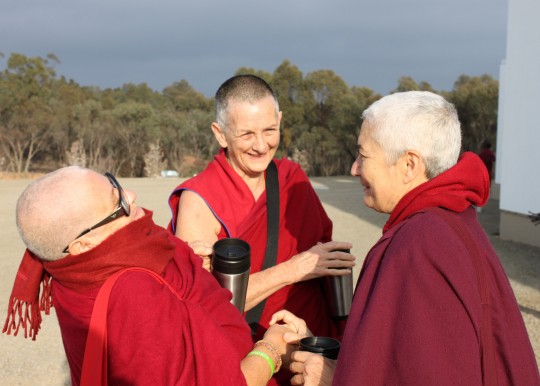
Vens. Siliana, Trisha and Paloma outside the Great Stupa of Universal Compassion, Australia, September 16, 2014. Photo by Laura Miller.
Ven. Roger Kunsang, CEO of FPMT, and Ven. Holly Ansett, FPMT charitable projects coordinator, spoke on Lama Zopa Rinpoche’s Vast Visions and the Five Pillars of Service. “The organization is about giving value or meaning to an individual’s life — giving us a clear understanding of our purpose of being,” Ven. Roger said as a way of orienting his presentation. “That’s what we do. That’s who we are. You can’t underestimate it. And I haven’t found anything better to do. The difference we’ve made in the world up to today, I’d say, it’s huge.” Lama Zopa Rinpoche arrived as Ven. Roger talked about the importance of Lama Yeshe and Lama Zopa Rinpoche to the work of FPMT and the importance of everyone offering service to FPMT and to the Lamas.
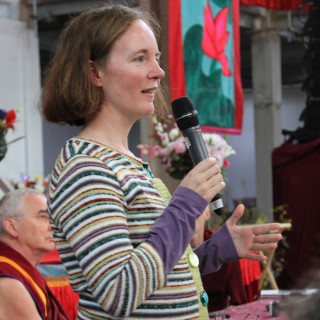
Linda Gyatso speaking on Day 4 at CPMT 2014, Great Stupa of Universal Compassion, Australia, September 16, 2014. Photo by Laura Miller.
Ven. Holly Ansett presented Lama Zopa Rinpoche’s Vast Visions for FPMT, describing the story behind it and its development with Rinpoche adding in commentary throughout. Ven. Holly described how much amazing work has already been done to actualize Rinpoche’s expansive wishes.
Linda Gyatso, the new director of the Foundation for Developing Compassion and Wisdom, introduced the organization. Linda explained that FDCW helps to develop and promote Universal Education for Compassion and Wisdom, the secular education programs and initiatives that have grown out of a vision articulated by Lama Yeshe.
After a tea break, Ven. Roger offered more insight into the importance of good local governance, emphasizing the critical role of a well-organized and educated local board of directors. He then discussed how the Five Pillars of Service are a way of translating the vast visions into goals to which centers can aspire that engage their communities most broadly. The Five Pillars are:
- Dharma
- Universal Education for Compassion and Wisdom
- Social and/or community service
- Interfaith activities
- Revenue generation activities
He explained that this isn’t new in the sense that many centers, projects and services are already engaged in many of these pillars.
Francois Lecointre, director of Institut Vajra Yogini (IVY) in France; Denise Macy, director of Land of Medicine Buddha (LMB) in California, US; and Fabienne Pradelle, director of Vajrapani Institute in California, explained how the work of their respective centers matches up with the Five Pillars.
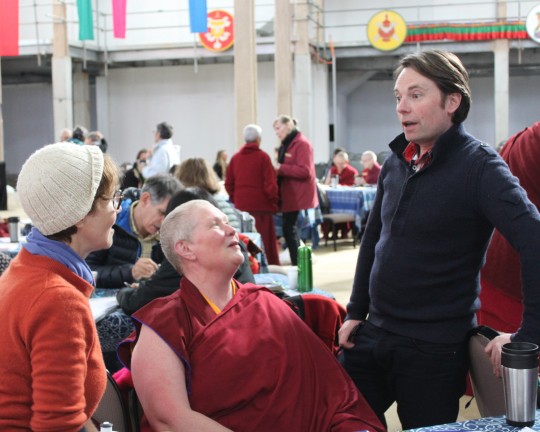
Wendy Cook, Ven. Lindy, Matthew Poxon during tea break on Day 4 at the Great Stupa of Universal Compassion, Australia, September 16, 2014. Photo by Laura Miller.
After a tasty lunch, three panelists addressed an issue critical for the development and growth of centers, projects and services in the session “Developing Fund Raising and Revenue Generation.”
Hup Cheng Tan, center director of Amitabha Buddhist Centre in Singapore, explained how ABC makes extensive offerings, hosts festivals and creates many, many activities for students to make offerings and to offer sponsorships. For many present, the scope and results of ABC’s activities were mind blowing. Hup Cheng also mentioned that ABC has a retail shop and used feng shui when designing their building, but emphasized that generosity and merit generation were at the heart of their revenue generation work.
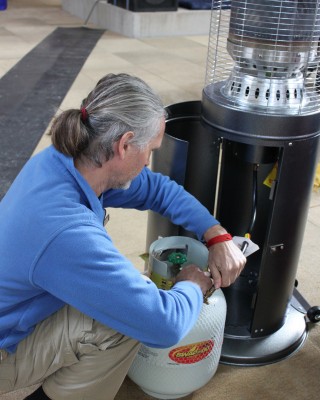
Harald Weichart helps change the fuel for the space heaters at CPMT 2014, Great Stupa of Universal Compassion, Australia, September 16, 2014. Photo by Laura Miller.
Tony Steel, center director of Vajrayana Institute, Sydney, Australia, explained how the center started to organize and host large conferences as a form of revenue generation, specifically “Happiness & Its Causes,” which has had His Holiness the Dalai Lama as a featured speaker, and also the conference “Mind & Its Potential.” Tony explained that he has drawn on his background in business while leading the center’s work in this area. As a way to evolve, Vajrayana is trying a new initiative: organizing exhibition events that generate money through selling sponsorships and exhibition space. They are currently working on one focused on wellness.
Sarah Brooks, spiritual program coordinator of Kadampa Center in Raleigh, North Carolina, US, explained how Kadampa Center operates on a donation only basis. She explained that at first the center tried raising funds by asking for a specific donation at events, but now they have no suggested donation, letting attendees decide their level of contribution. They also offer opportunities to sponsor teachers, pujas and holy days. Since they’ve moved to this model, they have been receiving more donations than before. The center also encourages students to set up a regular, automatic monthly donation, instead of trying to raise money with once a year type fundraising campaign. The center also makes sure to emphasize the practice of generosity and to show sincere gratitude to donors and active community members.
Ven. Holly was then invited to briefly list all of the incredible merit-generating activities that are being done through the FPMT Puja Fund. All present took a moment to rejoice in the beneficial activities being supported by this fund.
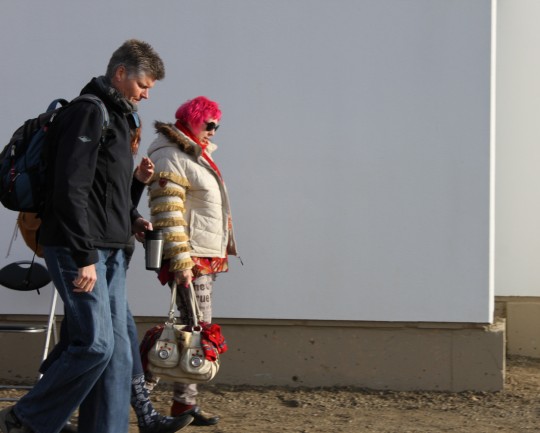
Jane Willis and Miffi Maximillion from Langri Tangpa Centre outside of the Great Stupa of Universal Compassion, Australia, September 16, 2014. Photo by Laura Miller.
At this point, the session was opened up to questions and sharing from the audience. Andy Wistreich from Land of Joy, a project to create a retreat center in the UK, announced that the project is completing the purchase of the property that they had found in northern England. In July 2014, Rinpoche visited and blessed the land.
“You create the merit and the money will come,” Andy explained. “It’s very important to not worry about money; worry about merit.” He continued that if you or your center asks Rinpoche a very specific question about creating merit for your project, you will get very specific advice. And if you properly carry out the advice, the money will come. He also said that Land of Joy hopes to employ a generosity model.
Denise Macy, from LMB, described some of her experiences with undertaking large projects and talked about a recent fundraising campaign. Members of the LMB community turned their very large prayer wheel continuously for 24 hours and exceeded their fundraising goals. She emphasized the importance of a “can do” attitude and a willingness to take a risk.
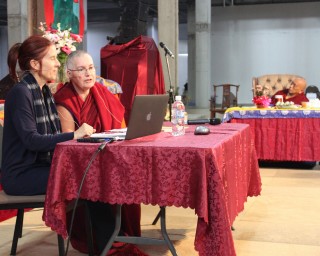
Ven. Chantal Carrerot and Drolkar McCallum leading a presentation on International Mahayana Institute with Lama Zopa Rinpoche listening on, CPMT 2014 Day 4, Great Stupa of Universal Compassion, Australia, September 2014. Photo by Laura Miller.
Miffi Maximillion, spiritual program director of Langri Tangpa Centre in Brisbane, Australia, explained the center’s popular “prostrate-a-thon,” in which participants took pledges for doing prostration for world peace. She said they saw the event primarily as a merit raising event and had “heaps of offerings” in the center during the event. In addition to creating merit, Miffi said the event also created a great community feeling.
Ven. Chantal Carrerot director of International Mahayana Institute (IMI) and Drolkar McCallum led a presentation on IMI, the community of FPMT’s monks and nuns. Ven. Chantal described the more than 40-year history of IMI and their invaluable contribution to building the international FPMT mandala; they were the “pioneers.” As of today, IMI had 280 Sangha members in 29 countries who are in retreat, studying, teachings and offering service. Participants talked with partners at their tables about the centers, projects and services that they knew of that have benefited from Sangha involvement. There were no shortage of instances to discuss. Then everyone took a few minutes to rejoice in all the activities of IMI Sangha members.
Drolkar then described current and future projects to support Sangha, drawing attention to the Lama Yeshe Sangha Fund. Afterwards, small groups gathered to discuss issues on Sangha and reported back to the large group.
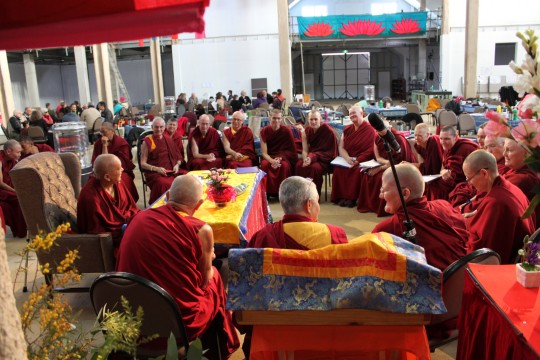
IMI Sangha members meeting with Rinpoche during the small group discussion period at CPMT 2014 Day 4, Great Stupa of Universal Compassion, Australia, September 16, 2014. Photo by Laura Miller.
Drolkar also led the end of day reflection, asking participants how they did with their practice of listening. “Was your listening unbiased? … Was it patient? … Did you listen with interest?” she asked. Lama Zopa Rinpoche, who had observed in most of the day’s meeting, led the dedication.
After dinner, Ven. Paloma Alba and Gun Cissé shared their stories about meeting the Dharma as part of the evening’s Wisdom Culture program. Like previous evenings’ presentations, despite the draft and chill in the stupa, their stories warmed the audience with laughter and inspiration.
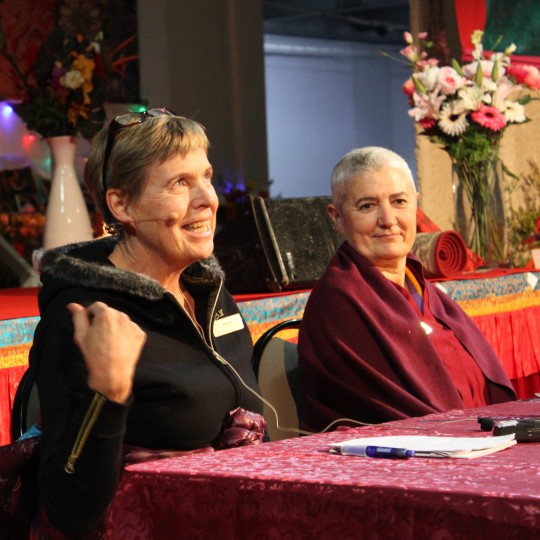
Ven. Paloma and Gun Cissé sharing their stories of meeting the Dharma, Day 4 CPMT 2014, Australia, September 16, 2014. Photo by Laura Miller.
Mandala will continue sharing updates and photos from the CPMT 2014 meeting as the meeting continues.
Mandala brings you news of Lama Zopa Rinpoche and of activities, teachings and events from over 160 FPMT centers, projects and services around the globe. If you like what you read on Mandala, consider becoming a Friend of FPMT, which supports our work.
15
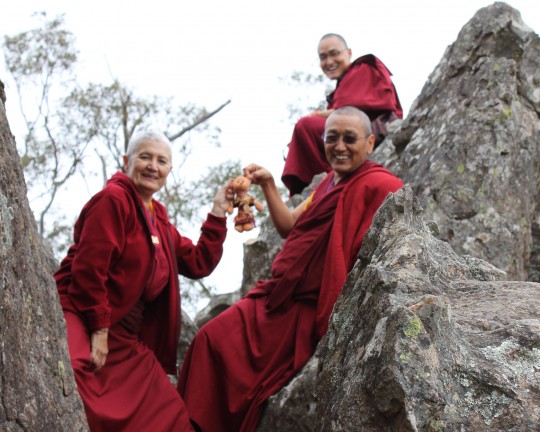
Khen Rinpoche Geshe Chonyi, Ven. Paloma Alba, Ven. Sherab and Teddy Tulku on top of Hanging Rock, Victoria, September 15, 2014. Photo by Laura Miller.
Day 3 of CPMT 2014 began, as each day does, with morning prayers before breakfast. Then, promptly at 8:45 a.m., the meeting part of the day started. First up, Helen Patrin, FPMT Australia coordinator, shared her experiences using the Inner Job Description (IJD), which she has been practicing for many months as part of the Foundation Services Seminar facilitator registration process. Helen then led the group through a brief reflection on developing skillful communication (from the IJD) so that one’s work for FPMT can be as beneficial as possible. The day before, Lama Zopa Rinpoche reminded participants what that work is. Rinpoche said during the open question section, “This [the FPMT] is not a company or a worldly life organization. It is not a political or government organization. This is purely to serve sentient beings.”
Tom Truty, director of FPMT Education Services, and Claire Isitt, Director of Center Services, gave a short presentation on the FPMT teacher registration process, which was drawn from Lama Zopa Rinpoche’s advice and guidance. They also covered new initiatives to support and further develop teachers. The presentation was followed by small group discussions on ways to support and develop new and existing teachers, which were reported back to the large group. The discussions were very productive based on the many and varied ideas that were shared.
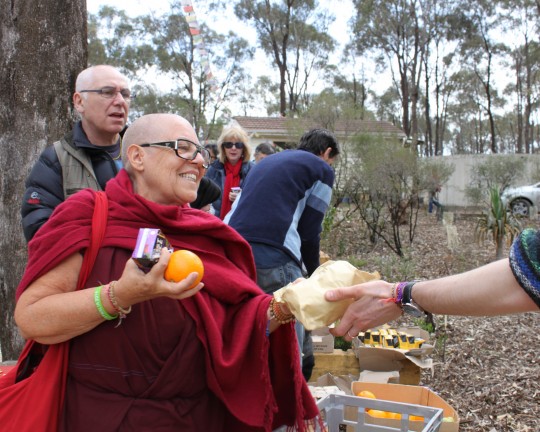
Ven. Siliana Bosa and Andy Melnic picking up lunch for getting on the bus for Hanging Rock, Atisha Centre, Australia, September 15, 2014. Photo by Laura Miller.
Claire Isitt and Drolkar McCallum, FPMT North America regional coordinator, led the second morning session, reviewing the aspects that comprise good local governance. The small group discussions that followed offered participants the opportunity to reflected on how to handle some of the difficulties that arise at centers on occasion and how good governance structures can help avoid situations were problems escalate.

Hiking under the Hanging Rock at Hanging Rock, Victoria, Australia, September 15, 2014. Photo by Laura Miller.
For lunch, most of the 114 meeting participants filled two highway buses for an afternoon picnic at Hanging Rock. The outing provided a needed break. Khen Rinpoche Geshe Chonyi went on the picnic and explored the picturesque site, smiling as he climbed on the rocks and got to know new people. Highlights included a refreshing walk to the top of Hanging Rock, climbing around in the pillar rock formations, seeing some of Australia’s distinctive wildlife, including wallabies and crimson rosellas, and casual conversations with old and new friends from around the world.
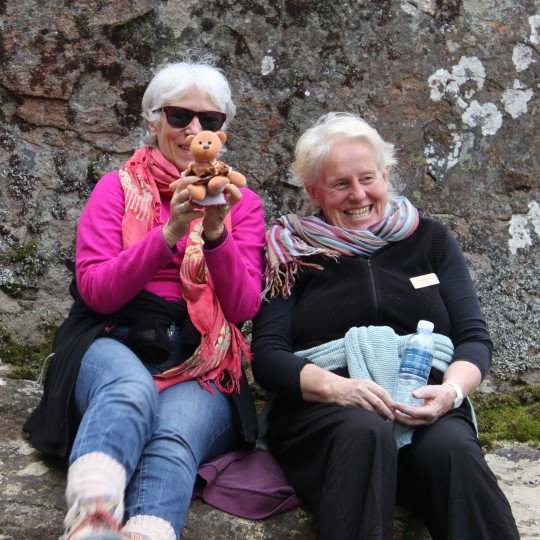
Teddy Tulku with Françoise Majesté-Larrouy and Olga Planken at Hanging Rock, Victoria, Australia, September 15, 2014. Photo by Tom Truty.
After returning to the Great Stupa and having a delicious soup dinner, participants gathered to listen to Gyatso (Adrian Feldmann), director of Thubten Shedrup Ling Monastery, who shared his story of getting hooked by Dharma in the early 1970s at Kopan and his work for the Lamas and FPMT that followed. Despite the chilly temperatures in the Great Stupa, Gyatso held the audience completely enraptured, receiving a hearty and warm round of applause at the end of the long day.
Mandala will continue sharing updates and photos from the CPMT 2014 meeting as it continues.
Mandala brings you news of Lama Zopa Rinpoche and of activities, teachings and events from over 160 FPMT centers, projects and services around the globe. If you like what you read on Mandala, consider becoming a Friend of FPMT, which supports our work.
- Home
- News/Media
- Study & Practice
- About FPMT Education Services
- Latest News
- Programs
- New to Buddhism?
- Buddhist Mind Science: Activating Your Potential
- Heart Advice for Death and Dying
- Discovering Buddhism
- Living in the Path
- Exploring Buddhism
- FPMT Basic Program
- FPMT Masters Program
- FPMT In-Depth Meditation Training
- Maitripa College
- Lotsawa Rinchen Zangpo Translator Program
- Universal Education for Compassion & Wisdom
- Online Learning Center
- Prayers & Practice Materials
- Overview of Prayers & Practices
- Full Catalogue of Prayers & Practice Materials
- Explore Popular Topics
- Benefiting Animals
- Chenrezig Resources
- Death & Dying Resources
- Lama Chopa (Guru Puja)
- Lama Zopa Rinpoche: Compendium of Precious Instructions
- Lama Zopa Rinpoche: Life Practice Advice
- Lama Zopa Rinpoche Practice Series
- Lamrim Resources
- Mantras
- Prayer Book Updates
- Purification Practices
- Sutras
- Thought Transformation (Lojong)
- Audio Materials
- Dharma Dates – Tibetan Calendar
- Translation Services
- Publishing Services
- Teachings and Advice
- Find Teachings and Advice
- Lama Zopa Rinpoche Advice Page
- Lama Zopa Rinpoche: Compendium of Precious Instructions
- Lama Zopa Rinpoche Video Teachings
- ༧སྐྱབས་རྗེ་བཟོད་པ་རིན་པོ་ཆེ་མཆོག་ནས་སྩལ་བའི་བཀའ་སློབ་བརྙན་འཕྲིན།
- Podcasts
- Lama Yeshe Wisdom Archive
- Buddhism FAQ
- Dharma for Young People
- Resources on Holy Objects
- Ways to Offer Support
- Centers
- Affiliates Area
- Teachers
- Projects
- Charitable Projects
- Make a Donation
- Applying for Grants
- News about Projects
- Other Projects within FPMT
- Support International Office
- Projects Photo Galleries
- Give Where Most Needed
- FPMT
- Shop
Subscribe to FPMT News
Translate*
*powered by Google TranslateTranslation of pages on fpmt.org is performed by Google Translate, a third party service which FPMT has no control over. The service provides automated computer translations that are only an approximation of the websites' original content. The translations should not be considered exact and only used as a rough guide.Once you realize the true evolution of your mental problems, you’ll never blame any other living being for how you feel.






